US Army Trucks of the Cold War to this day
 Over 10,000,000 vehicles 1947-Today
Over 10,000,000 vehicles 1947-Today
About US Trucks from 1947 to this day

During the Cold War, the United States developed and deployed a variety of trucks for military use. These trucks were designed to transport troops, equipment, and supplies in a variety of environments, including the harsh cold weather conditions of Europe and other regions.
One of the most iconic trucks used by the US military during the Cold War was the M35 "Deuce and a Half" truck. This was a two-and-a-half-ton cargo truck that was used extensively by the US Army from the 1950s through the 1990s. The M35 was designed to be highly reliable and capable of operating in a variety of environments, including the extreme cold weather conditions of northern Europe.
In addition to the M35, the US military also deployed a variety of other trucks during the Cold War, including the M54, M809, and M939 series of cargo trucks. These trucks were larger and more powerful than the M35, and were capable of carrying heavier loads over longer distances.
The US military also developed specialized trucks for use in cold weather conditions, including the M123A1C tractor and M127A1C semi-trailer combination. These trucks were used to transport fuel and other critical supplies to remote locations in Alaska and other cold weather regions.
Overall, the US military's truck fleet played a critical role in supporting its Cold War operations, allowing troops and supplies to be rapidly transported across large distances and difficult terrain, and this between the Korean War, Vietnam war, Nigaragua Intervention, Somalia, Gulf War, Iraq and Afghanistan. With constant deployments, specifications and usage changed over time. And it was not just about softskin trucks and light tactical vehicles (classed as "trucks" anyway, the difference was in the weight load), but also artillery tractors such as the M578.

In search for the new light US Army workhorse
Post-war military Jeeps
The original WW2 Jeep was used and imitated around the world. France for example copied it via Delahaye and Hotchkiss, and the latter after 1954 manufactured Jeeps under license. In Japan it was built by Mitsubishi Motors and Toyota. The
British Land Rover was also largely inspired by the Jeep, as the British Army avidly used it in WW2. This utilitarian vehicle was hailed by industrial designers and museum alike, the Museum of Modern Art describing it as a masterpiece of functionalist design. Ernie Pyle called it, with the G.I. Pocket Stove, "the two most important pieces of noncombat equipment ever developed." These arrived soon also on the surplus market. Civilian applications were legion, pushing the chassis and engines to their extreme limited, like the Philippine's Jeepney, a stretched-out heavily modified bus made from a Jeep, also heavily decorated. Comimg from surplus MBs and GPWs, they have become a symbol of "modern" Philippines. Backyard assemblers also constructed replica Jeeps with stainless steel bodies and surplus parts for the local market.
In the US military, the Jeep started to age in the 1950s and found several successions, each time only gradually improved but very much on the same flavour as the original. Outside the CJ, earliest derivative mostly used abroad, the M38 was soon the true successor of the model, and the Ford M151 Mutt in the 1970s, up to the Humvee.

The Willys GP was followed by CJ at the end of the war, a version aimed at former GI and more in tune with Civilioan specifications, in short, "demilitarized". It was thus not used officially by the US Army, but produced to a very large amount in several sub-variants until 1970, used in many militaries throughout the world. Here a CJ-3B with tarpaulin.
Willys CJ-V35/U
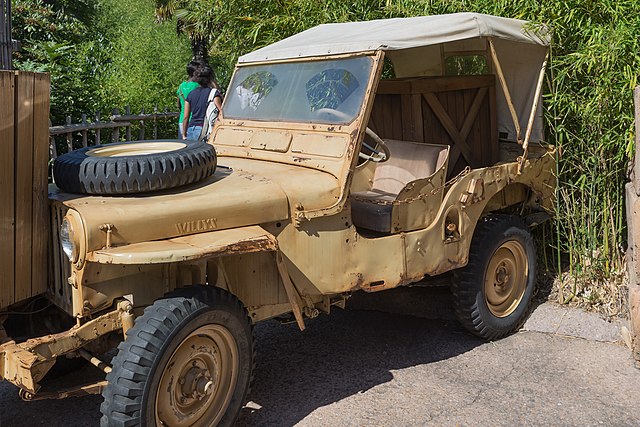
After World War II, Jeep began to experiment with new designs and notably a model that can still running underwater. On February 1, 1950, a contract was approved for 1,000 vehicles called the CJ-V35/U (U standing for Underwater) which were "especially adapted for general reconnaissance or command communications" and capable of operating for short period underwatern usable both for landing and fording, the engine having a snorkel system to breathe underwater. Of course the amount of water it could ford was directly linked to the height of the snorkel mast. It inspired however a whole generation of snorkel-equipped 4x4 vehicles, enabling unprecedented mobility. Note: no cc photo of the vehicle, here is the CJ-3A instead.
More info
Willys M715 (1965)
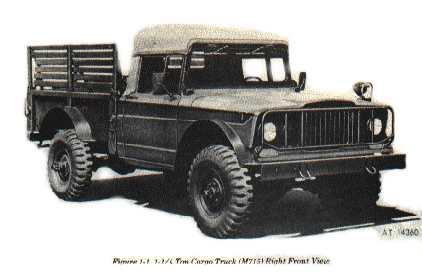
The Jeep M715 developed in 1965 is another interesting development, of a much larger vehicle called 1.25-short-ton army truck. It was a "remilitarized" version of the civilian J-series, and it served extensively in the Vietnam War. It had haeavier full-floating axlesp plus a foldable flat windshield. It is still used by the military of many countries and produced by Kia under license.
Willys MC/M38 (1949-52)

This was the first true sucessor of the famous Jeep, an all-out improvement of the original by the very same company. The vehicle general outlook was still very reminiscent of the MB. It was extensively used in the Korean War, Vietnam War, Laotian Civil War, Lebanese Civil War and many other conflicts as it saw extensive use abroad as well. It was produced by Willys-Overland from 1949 to 1952 to an extent of 45,473, a far cry from WW2 production, but still impressive nonetheless. Here a M38A1 of the Vietnam war.
Willys M606 (1953-68)
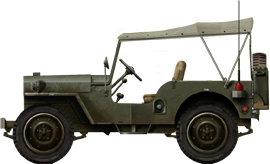
The M606 was the military equivalent to the CJ-3B, only variant used in limited numbers with the US Army. It was pretty much just the CJ-3B straight off the assembly line but with heavy-duty options like larger tires and springs, a special rear bumper to hold the Pintle Hook and bumperettes, a black-out lamp on the front left fender, and specific windshield not used on civilian models. It was widely exported.
M151 Mutt (1959-88)
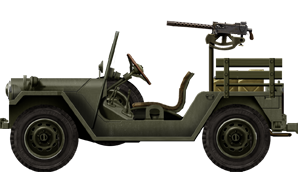
Along with the "Mighty Mite" this was the last attempt to provide the US Military with a worthy successor of the Jeep, in its primitive form. It was produced to an extent of 100,000 vehicles by Ford, Kaiser, and AM General.
Called Truck, Utility, ¼-Ton, 4×4, M151 or simply M151, it was the successor to the Korean War M38 and M38A1 jeep. The M151 had an integrated body design which offered a little more space than prior jeeps, and featured all-around independent suspension with coil springs. More modern than the WW2 Willys celebrity, it was also largely exported and built under licence, and saw action in the Vietnam war.
M422 Mighty Mite (1959-62)

Last "classic" open light general purpose vehicle of the US Amy before the new armored standard that was the Hummer or HMMV, the M422 was manufactured by American Motors Corporation (AMC) as an airborne, lightweight version of the Jeep. Called the "lightweight ¼-ton 4x4 tactical truck", it was mostly used by the US Marines, and heliborne, making its baptism of fire in Vietnam. Only 1,250 and 2,672 M422A1 were manufactured total.
M274 1/2-ton 4x4 Mule (1959-62)

The U.S. Military M274 Truck, Platform, Utility, 1/2 Ton, 4X4 is a singular vehicle in US ordnance. A barebone "Carrier, Light Weapons, Infantry, 1/2 ton, 4x4" popularly known as the "Mule" or the "Military Mule", or "Mechanical Mule". It was a 4-wheel drive, gasoline-powered tractor vehicle able to carry just 1/2 short ton (0.45 tonnes) off-road. The engine was placed under the main platform to spare space and the driver was located on a left-side seat with pedals, gears and a wheel, and... nothing else. The vehicle was super-light, compact to be dismounted and air-transportable by any helicopter. It was used notabl in Vietnam as a way to accompany troops with their gear and supply.
HMMWV (1982)
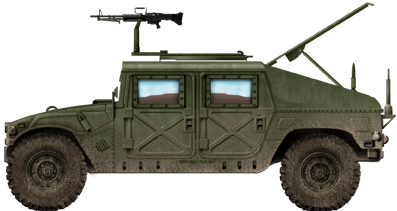
The HMMWV, also known as the Humvee, is a military vehicle that was designed and produced by AM General Corporation for the United States military. It was first introduced in 1984 as a replacement for the aging fleet of military jeeps. The HMMWV was designed to be a highly mobile, all-terrain vehicle that could transport troops, supplies, and equipment in a variety of combat situations. It has a low profile, which makes it less visible to enemy forces, and it is highly maneuverable, which allows it to navigate rough terrain and tight spaces.
The HMMWV is powered by a diesel engine and is equipped with four-wheel drive and independent suspension. It can carry up to four passengers and has a payload capacity of over 2,500 pounds. The vehicle can also be outfitted with a variety of weapons and other equipment to suit a variety of missions. The HMMWV has been used extensively by the US military in a variety of conflicts, including the Gulf War, the Iraq War, and the War in Afghanistan. It has also been sold or given to foreign militaries and civilian organizations, and it has become a popular subject for customization and modification by civilian enthusiasts.
See the full article here. Note: It's not featured in truck encyclopedia, due to the fact the Humvee is not "soft-skinned" but has a light but efficient High-Tensile aluminium 8 mm (0.3-in) armour. It's true from most MPVs developed for Iraq and Afghanistan in the 1995-2010 period.
Desert Patrol Vehicle (1991)
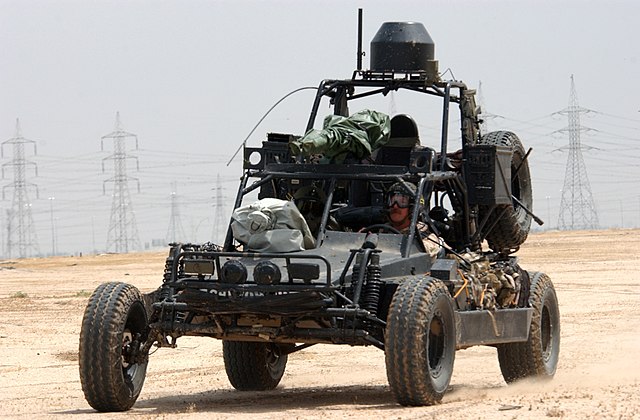
The Desert Patrol Vehicle (DPV) is a high-speed, off-road vehicle that was developed for use by the United States military. It was specifically designed to operate in desert environments and was used extensively during the Gulf War and other military operations in the Middle East. The DPV is a lightweight, two-person vehicle that is powered by a high-performance engine and is equipped with a long-travel suspension system. It has a top speed of over 80 miles per hour and can travel over rough terrain, sand dunes, and other obstacles with ease.
The DPV is designed to be highly maneuverable, with a small turning radius and a low center of gravity. It is also equipped with advanced navigation and communication systems, which allow it to operate effectively in the harsh and remote desert environments. The DPV was used extensively by US special forces during the Gulf War, where it was used for reconnaissance, surveillance, and other special operations. It has since been replaced by newer vehicles, but it remains a popular vehicle among military enthusiasts and has been used in civilian racing and off-road competitions.

The Interim Fast Attack Vehicle (IFAV) is a lightweight, high-mobility vehicle that was developed for the United States Marine Corps (USMC) in the early 2000s. It was designed to provide USMC infantry units with a fast, agile, and versatile vehicle that could be rapidly deployed to remote and rugged terrain. The IFAV is a four-wheel-drive vehicle that is powered by a diesel engine and is equipped with a four-speed automatic transmission. It has a top speed of around 90 miles per hour and can traverse a variety of terrains, including sand, rocks, and mud.
The IFAV can carry up to four passengers and is equipped with a variety of weapon systems, including machine guns and grenade launchers. It is also equipped with advanced navigation and communication systems, which allow it to operate effectively in the field. The IFAV was used by USMC units in Iraq and Afghanistan, where it was used for a variety of missions, including reconnaissance, surveillance, and convoy escort. It was later replaced by the more advanced and capable Joint Light Tactical Vehicle (JLTV), which entered service in the mid-2010s.
M1161 Growler (1999)
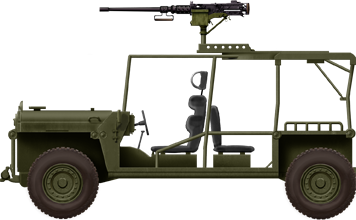
The M1161 Growler is a light tactical vehicle developed for the United States Marine Corps (USMC) by General Dynamics. It is a four-wheel-drive vehicle that is designed to provide USMC infantry units with a fast, agile, and versatile vehicle that can be rapidly deployed to remote and rugged terrain. The Growler is powered by a 1.9-liter turbocharged diesel engine and is equipped with a four-speed automatic transmission. It has a top speed of around 80 miles per hour and can traverse a variety of terrains, including sand, rocks, and mud.
The Growler can carry up to four passengers and is equipped with a variety of weapon systems, including machine guns and grenade launchers. It is also equipped with advanced navigation and communication systems, which allow it to operate effectively in the field. The Growler has been used by USMC units in Iraq and Afghanistan, where it has been used for a variety of missions, including reconnaissance, surveillance, and convoy escort. It has also been sold or given to foreign militaries, including the armed forces of the United Arab Emirates and the Republic of Korea. The Growler is still in service with the USMC and remains a popular vehicle among military enthusiasts.
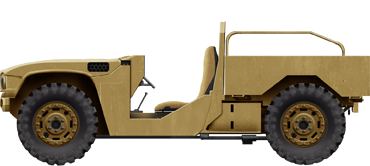
The Boeing Phantom Badger is a lightweight tactical vehicle developed by the Boeing Defense, Space & Security division for use by military and special forces units. It is designed to be highly versatile, adaptable, and easy to transport to remote and rugged terrain. The Phantom Badger is a four-wheel-drive vehicle that is powered by a diesel engine and is equipped with a six-speed automatic transmission. It has a top speed of around 80 miles per hour and can traverse a variety of terrains, including sand, rocks, and mud.
The Phantom Badger can carry up to four passengers and is designed to be modular, with a variety of configurations that can be easily adapted to different mission requirements. It can be outfitted with a variety of weapon systems, including machine guns and grenade launchers, and is also equipped with advanced navigation and communication systems. The Phantom Badger is designed to be easily transportable, with a low weight and compact dimensions that allow it to be carried by a variety of military aircraft, including helicopters and transport planes. It can also be rapidly deployed and operated in a variety of scenarios, including reconnaissance, surveillance, and convoy escort.
The Phantom Badger has been used by US special forces and other military units in a variety of conflicts, including in Afghanistan and Iraq. It remains a popular vehicle among military enthusiasts and has also been adapted for use in civilian applications, such as search and rescue and emergency response.
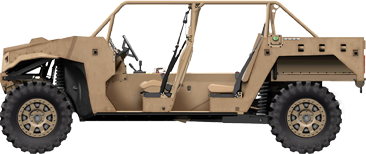
The Polaris DAGOR (Deployable Advanced Ground Off-Road) is a lightweight, off-road vehicle developed by Polaris Defense for military use. It is designed to provide transport and support for infantry units in remote and rugged terrain.
The DAGOR is a four-wheel-drive vehicle that is powered by a diesel engine and is equipped with an automatic transmission. It has a top speed of around 80 miles per hour and can traverse a variety of terrains, including sand, rocks, and mud. The DAGOR can carry up to nine passengers and is equipped with a variety of weapon systems, including machine guns and grenade launchers. It is also equipped with advanced navigation and communication systems, which allow it to operate effectively in the field.
The DAGOR is designed to be easily transportable, with a low weight and compact dimensions that allow it to be carried by a variety of military aircraft, including helicopters and transport planes. It can also be rapidly deployed and operated in a variety of scenarios, including reconnaissance, surveillance, and convoy escort. The DAGOR has been used by the US military and other militaries around the world in a variety of conflicts, including in Afghanistan and Iraq. It remains a popular vehicle among military enthusiasts and has also been adapted for use in civilian applications, such as search and rescue and emergency response

US military truckers, just like in WW2, used to bear a military uniform logo with a unique meaning, beside their unit. It is not only the logo of the military unit, but also a symbol of the honor and identity of the soldiers. Military units can incorporate military elements such as the name of the unit, logos of different levels, and honor into the design of
Custom Military Patches.
Such personalized military patches can not only inherit and promote the military spirit, but also enhance the cohesion of the army.
US Army Trucks from 1947 to this day
Compared to the situation in WW2, the ordnance bureau in the cold war, when asked to gradually replace its park of worn-out mass-built trucks, like the iconic GMC CCKW choose a universal platform that could be used for all tasks and specialities, the Reo (and many others) M35 (175,000 built and more) or the M39 (same specs) by International Harvester, declined into multiple version such as the M54 tactical truck (150,000+). But the need for smaller trucks led to define also the M37 3/4-ton 4x4 (136,000 built) which soldiered in the Korean War and Vietnam.
Dodge M37 3/4-ton 4x4 (1951)

The Dodge M37 is a three-quarter ton four-wheel drive truck that was designed for military use and was manufactured by Dodge during the period from 1951 to 1968. It was primarily used by the United States Army and other military organizations. The M37 was powered by a Dodge T-245 gasoline engine, which was a six-cylinder inline engine that produced around 78 horsepower. The engine was mated to a four-speed manual transmission and a two-speed transfer case, which allowed the driver to select either two-wheel or four-wheel drive.
The M37 was designed to be a versatile vehicle that could be used for a variety of purposes, including troop transport, cargo transport, and as a platform for mounting weapons. It was also used for civilian purposes after its military service, such as a fire truck, ambulance, or even as a snowplow. The Dodge M37 is considered a rugged and reliable vehicle, and it has gained a following among collectors and enthusiasts of military vehicles.
Reo 2+1/2-ton 6x6 M35 (1950)
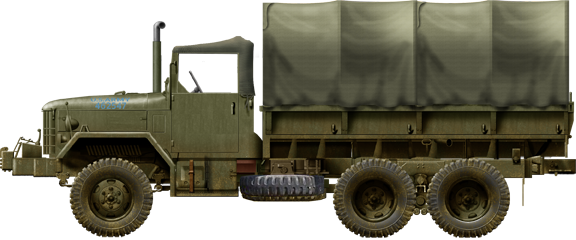
The M35 series 2½-ton 6×6 cargo truck is the emblematic cold war US military truck. It was produced from 1950 to this day, and it's not over, as the basic vehicle was constantly upgraded and modernized to stand the test of time. Design by REO in 1949 it was mass-produced by REO, Kaiser, Studebaker, and AM General. It was also the main army truck of South Korea, produced by Kia and Ssangyong as well as the Canadian Armed Forces by Bombardier. The main US version were produced from 1950 to 1988 for the M35A1 and M35A2 and from 1994 to 1999 M35A3, until replacement by the HMTT family.
M39 5-ton 6x6 (1951)
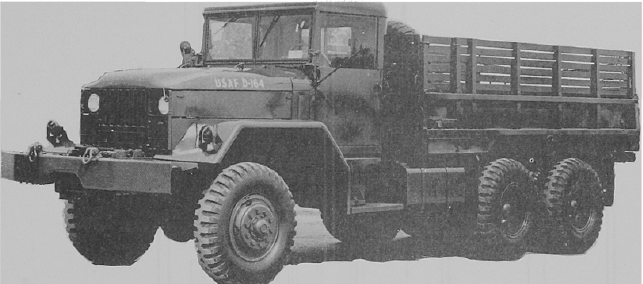
The M39 series is a family of 5-ton 6x6 military trucks that were produced by the United States Army in the 1950s and 1960s. The trucks were designed to be used for a variety of purposes, including cargo transport, troop transport, and as a platform for mounting weapons. The M39 series included several different models, including the M39, M40, M41, M42, and M44. These models differed in terms of their wheelbase, body style, and equipment, but they all shared a common chassis and drivetrain.
The M39 series was powered by a Continental LDS-465-1A six-cylinder turbocharged diesel engine, which produced around 175 horsepower. The engine was mated to a five-speed manual transmission and a two-speed transfer case, which allowed the driver to select either two-wheel or six-wheel drive. The M39 series was known for its durability and reliability, and it was used by the United States Army and other military organizations for several decades. The trucks were eventually phased out of military service in the 1990s, but many have since been sold to civilian buyers and are still in use today as heavy-duty work trucks or as vehicles for off-road adventures.
M123/M125 10-ton 6x6 truck (1955)

In the segment of heavy trucks, still 6x6 and off-road, Mack came as usual with a solid contender. The M125 is a 10-ton 6x6 military truck that was produced by the United States Army in the 1950s and 1960s. It was primarily used for cargo transport, and it was designed to be able to carry heavy loads over rough terrain. The M125 was powered by a Cummins NHC-250 six-cylinder diesel engine, which produced around 250 horsepower. The engine was mated to a five-speed manual transmission and a two-speed transfer case, which allowed the driver to select either two-wheel or six-wheel drive.
The M125 had a large cargo bed with fold-down sides, and it could be equipped with a canvas cover for protection from the elements. The truck also had a winch mounted on the front bumper, which could be used to pull other vehicles or to move heavy objects. The M125 was known for its ruggedness and durability, and it was used by the United States Army and other military organizations for several decades. It was eventually phased out of military service in the 1980s, but some examples have since been sold to civilian buyers and are still in use today as heavy-duty work trucks or for off-road adventures. "Only" 4,132 M123/125 semi-tractor for tank transporter prime mover cargo truck were produced by Mack and CONDEC until 1969. As usual in the late 1980s they ended in the national guard.
Kaiser Jeep M715 1+1/4-ton 4x4 (1967)

The M715 is a 1¼-ton 4x4 military truck that was produced by the United States Army from 1967 to 1969. It was based on the civilian Jeep Gladiator truck but was modified for military use. The M715 was powered by a 230 cubic inch (3.8-liter) inline six-cylinder gasoline engine that produced around 132 horsepower. The engine was mated to a four-speed manual transmission and a two-speed transfer case, which allowed the driver to select either two-wheel or four-wheel drive.
The M715 had a heavy-duty chassis and suspension, as well as a reinforced body and bed for carrying cargo. It also featured a 24-volt electrical system, blackout lights, and a front-mounted winch. The M715 was primarily used for troop transport, cargo transport, and as a platform for mounting weapons. It was eventually phased out of military service in the 1980s, but many examples have since been sold to civilian buyers and are still in use today as off-road vehicles or as collector's items. The M715 has gained a following among enthusiasts of military vehicles and off-road vehicles, and it is known for its ruggedness and durability. It was also the last vehicle produced by the Jeep Corporation for military use. In total, between 30,500 and 33,000 were built.

Chance vought M561 1+1/4-ton 6x6 "Gama Goat" (1969)
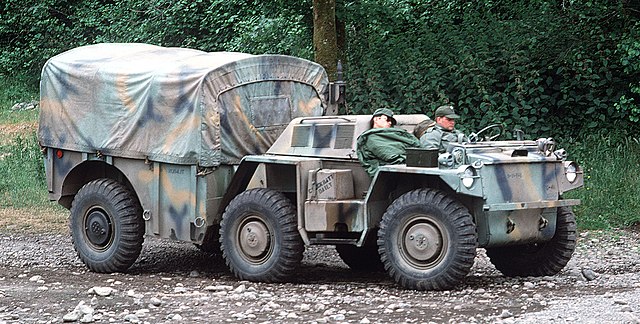
The M561, commonly known as the "Gama Goat," is a six-wheel drive amphibious vehicle that was developed by the United States Army in the late 1960s. It was designed to be used for a variety of purposes, including cargo transport, troop transport, and as a platform for mounting weapons.
The Gama Goat was powered by a Detroit Diesel 3-53T three-cylinder two-stroke diesel engine that produced around 175 horsepower. The engine was mated to a four-speed manual transmission and a two-speed transfer case, which allowed the driver to select either two-wheel or six-wheel drive. The Gama Goat had a unique articulated design, which allowed it to navigate rough terrain and cross bodies of water. It also had a large cargo bed and could be equipped with a canvas cover for protection from the elements.
Despite its innovative design, the Gama Goat was not without its issues. It was known for being difficult to maintain and repair, and it was eventually phased out of military service in the 1990s. Today, the Gama Goat is considered a collector's item among enthusiasts of military vehicles and off-road vehicles. Its unusual design and amphibious capabilities make it a unique and interesting vehicle to own and operate.
M656 5-ton 8x8 truck (1968)
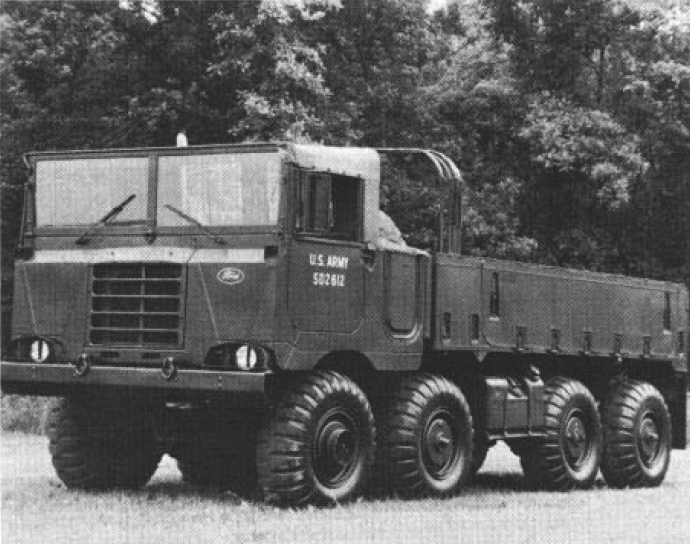
The M656 is a 5-ton 8x8 military truck that was produced by the United States Army in the 1960s and 1970s. It was primarily used for cargo transport and was designed to be able to carry heavy loads over rough terrain. The M656 was powered by a Continental AVDS-1790-2A eight-cylinder diesel engine, which produced around 450 horsepower. The engine was mated to an Allison MT654CR six-speed automatic transmission and a two-speed transfer case, which allowed the driver to select either two-wheel or eight-wheel drive.
The M656 had a large cargo bed with drop sides and a tailgate, and it could be equipped with a canvas cover for protection from the elements. The truck also had a hydraulic crane mounted on the bed, which could be used to lift and move heavy objects. The M656 was known for its ruggedness and durability, and it was used by the United States Army and other military organizations for several decades. It was eventually phased out of military service in the 1990s, but some examples have since been sold to civilian buyers and are still in use today as heavy-duty work trucks or for off-road adventures. It was produced by Ford in 1968-69 and made into six versions, including several dedicated to use the Pershing 1a missile.
CUCV/COTS M880/980 (1976)
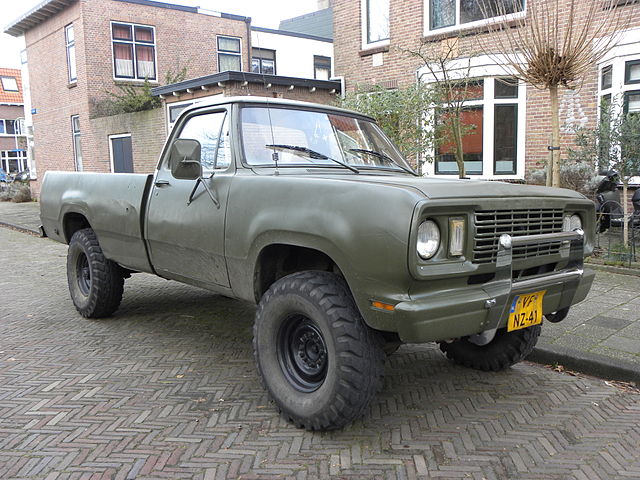
The concept of "technicals", mostly Toyota pickups featured in many civil wars and in asymetric warfare gave the idea to the post-Vietnam cash-strapped US military to launch the "Commercial Utility Cargo Vehicle", based on civilian models (Dodge here) and produced to military-grade to some 44,000 units in 1976–1977 with Dodge components at Warren Truck Assembly. After the CUCV II in 1987 by Chevy, appeared the last generation LSSV by GM. It's still an ongoing concept which found a lot of resonance in militaries around the world.
M809 series 5-ton 6×6 truck (1970)

The M809 series is a family of 5-ton 6x6 military trucks that were produced by the United States Army from the 1970s through the 1990s. The series includes several different variants, including cargo trucks, dump trucks, and wrecker trucks. The M809 trucks were powered by a Cummins NTC 855 diesel engine, which produced around 250-335 horsepower depending on the variant. The engine was mated to a five- or six-speed manual transmission and a two-speed transfer case, which allowed the driver to select either two-wheel or six-wheel drive.
The cargo variants of the M809 had a large open bed with fold-down sides, while the dump trucks had a hydraulic dump bed for unloading cargo. The wrecker variant had a heavy-duty crane mounted on the back for lifting and towing disabled vehicles. The M809 trucks were known for their ruggedness and durability, and they were used by the United States Army and other military organizations for several decades. They were eventually phased out of military service in the 2000s, but many examples have since been sold to civilian buyers and are still in use today as heavy-duty work trucks or for off-road adventures. The M809 series of trucks have a large following among military vehicle enthusiasts and collectors due to their distinctive design, impressive capabilities, and historical significance. It was produced to by AM General in 1970–1982 and replaced by the M890, often refurbished M809.
M939 series 5-ton 6×6 truck (1982)
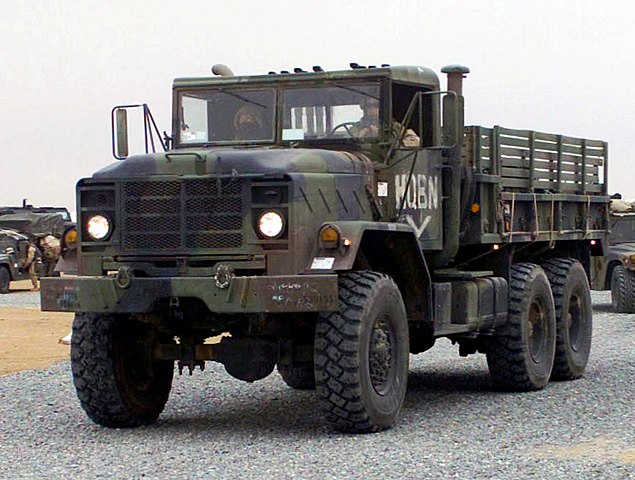
The M939 series is a family of 5-ton 6x6 military trucks that were produced by the United States Army from the 1980s through the 1990s. The series includes several different variants, including cargo trucks, dump trucks, and tractor trucks. The M939 trucks were powered by a Cummins NHC-250 diesel engine, which produced around 240 horsepower. The engine was mated to a five-speed manual transmission and a two-speed transfer case, which allowed the driver to select either two-wheel or six-wheel drive.
The cargo variants of the M939 had a large open bed with fold-down sides, while the dump trucks had a hydraulic dump bed for unloading cargo. The tractor variant was designed to pull heavy trailers, and it had a fifth-wheel hitch mounted on the frame. The M939 trucks were known for their ruggedness and durability, and they were used by the United States Army and other military organizations for several decades. They were eventually phased out of military service in the 2000s, but many examples have since been sold to civilian buyers and are still in use today as heavy-duty work trucks or for off-road adventures.
The M939 series of trucks have a large following among military vehicle enthusiasts and collectors due to their distinctive design, impressive capabilities, and historical significance. They are also popular among off-road enthusiasts, who appreciate their durability and ability to tackle tough terrain.
M520 Truck, Cargo, 8-ton, 4x4 Goer (1972)
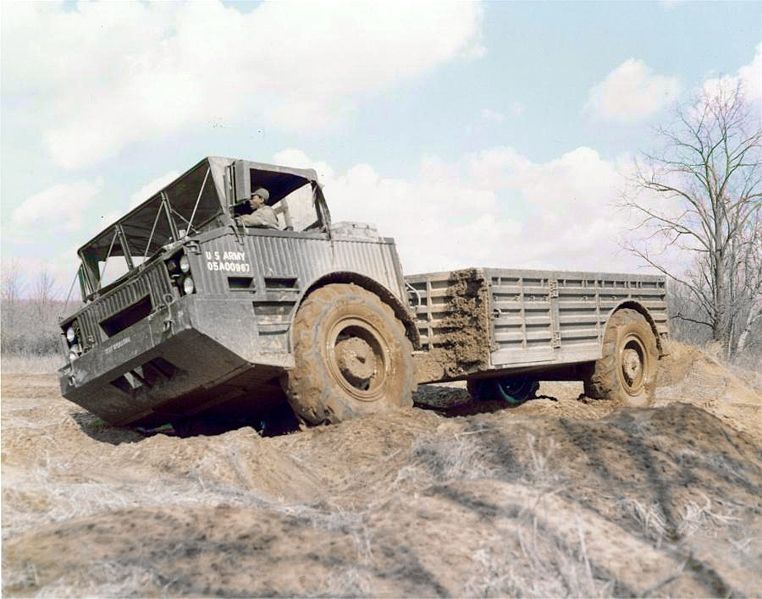
The M520 Goer is a military vehicle that was first introduced in the early 1950s. It was designed and built by the Pacific Car and Foundry Company, which is now known as PACCAR Inc. The M520 Goer was primarily used by the United States Army as a heavy-duty transporter for a variety of equipment, including tanks, artillery pieces, and other heavy vehicles. It was also used for other military operations such as the construction of bridges and other infrastructure.
The M520 Goer had a unique design that included a front-mounted engine and a hydraulically-powered steering system that allowed it to navigate rough terrain and tight spaces. It was powered by a 375 horsepower diesel engine and had a top speed of 35 miles per hour. The M520 Goer was replaced by newer military vehicles in the 1980s, but some units remain in service with foreign militaries and civilian contractors. In total, 1400 were built until 1976 in the M520 Cargo, M559 Fuel Servicing Tanker Truck, and M553 Wrecker Truck as well as the M877 Cargo Truck with Material Handling Crane.
M915 Truck, Tractor, 14-ton, 6x4 (1975)

The M915 is a series of heavy-duty trucks that were produced for the United States military by Freightliner Corporation in the 1970s and 1980s. The trucks were designed to transport heavy equipment and supplies, and they were used in a variety of military operations. The M915 series includes several variants, including the M915 tractor truck, which is designed to haul semi-trailers, and the M916 light equipment transporter, which is designed to carry heavy equipment and supplies on a flatbed trailer.
The M915 series is powered by a 14-liter Detroit Diesel engine and is equipped with an Allison automatic transmission. The trucks have a maximum speed of around 60 miles per hour and a range of approximately 500 miles.
The M915 series was widely used by the US military during the 1980s and 1990s, and many of these trucks were also sold or given to foreign militaries after they were retired from US service. Some M915 trucks have also been converted for civilian use, including as heavy-duty tow vehicles and as transporters for oversized cargo.
M911 Tractor Truck (1978)
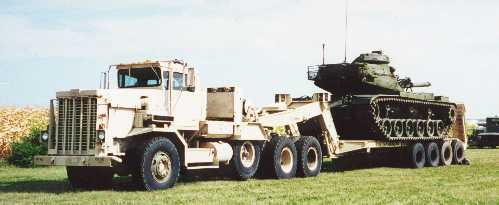
The M911 tank transporter is a heavy-duty truck designed to haul tanks and other armored vehicles. It was produced by the American truck manufacturer Kenworth in the late 1970s and early 1980s for the United States Army. The M911 features a powerful 500 horsepower Cummins diesel engine, an Allison automatic transmission, and a hydraulically operated fifth wheel for connecting to a trailer. It also has a hydraulic winch for loading and unloading tanks and other heavy equipment.
The M911 was designed to work in tandem with the M747 heavy equipment transporter trailer, which was specifically designed to transport tanks and other large military vehicles. Together, the M911 and M747 formed a powerful combination that could transport some of the heaviest and most powerful military vehicles in the US Army's inventory.
The M911 and M747 were both used extensively during the 1980s and 1990s, but they were eventually replaced by newer models. Some M911s and M747s remain in use with the US military today, and they have also been sold or given to foreign militaries after they were retired from US service.
To Come:
- HEMTT M977 10-ton 8x8 (1982)
- M915A2 series 15-ton[v] 6x4 (1990)
- LMTV[t] M1078 2+1⁄2-ton 4x4 (1991)
- Freightliner HET[x] M1070 Heavy 8x8 (1993)
- MTVR 7-ton 6x6 (1999)
- 7000MV HD 6x6 (2005)
- MTV M1083 5-ton 6x6 (2005)
- LVSR Heavy 10x10 (2009)
Soft-Skinned Artillery Tractors
 M4 High Speed Tractor, too late for WW2, right for the Korean War
M4 High Speed Tractor, too late for WW2, right for the Korean War
 M8A1 High Speed Tractor
M8A1 High Speed Tractor
 M548 tractor, from the Vietnam to the Gulf War.
M548 tractor, from the Vietnam to the Gulf War.
![]()
During the Cold War, the United States military deployed a variety of artillery tractors to transport artillery pieces and other heavy equipment. These tractors were designed to be highly maneuverable and capable of operating in a variety of environments, including rough terrain and extreme cold weather conditions. One of the most widely used artillery tractors during the Cold War was the M578 Light Recovery Vehicle. This vehicle was based on the M107 self-propelled howitzer chassis and was used primarily to recover and tow damaged or disabled vehicles, including artillery pieces.
Another commonly used artillery tractor was the M548 tracked cargo carrier. This vehicle was designed to transport ammunition, supplies, and other equipment, and was capable of carrying up to 10,000 pounds of cargo over rough terrain.
The M578 and M548 were both used extensively by the US military during the Cold War, and were deployed in a variety of conflicts, including the Vietnam War and the Gulf War. These vehicles were praised for their reliability and versatility, and played a critical role in supporting artillery operations on the battlefield.
In addition to these vehicles, the US military also deployed a variety of other artillery tractors during the Cold War, including the M35 cargo truck, which was often used to transport artillery pieces and other heavy equipment, and the M114 armored personnel carrier, which was sometimes used as a towing vehicle for smaller artillery pieces.
(More to come)
Links/Src
Books
Encyclopedia of Modern U. S. Military Tactical Vehicles
M520 Goer - M561 Gama Goat Articulated Trucks of the US Army in the Cold War - Tankograd 3018
Links
Willys M606 on military-vehicle.org
bizarre-american-gun-trucks-in-iraq
Videos